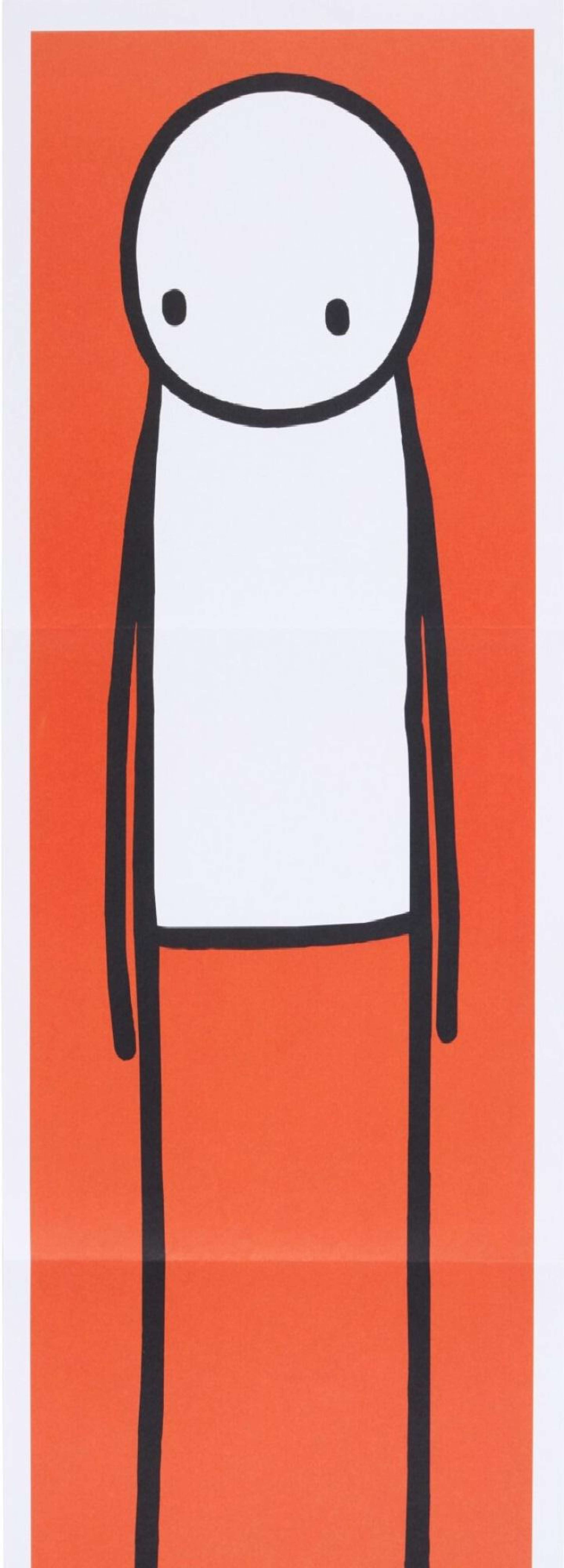 Walk (yellow) © Stik, 2012
Walk (yellow) © Stik, 2012
Stik
55 works
Stik's walking figures represent the ceaseless movement of the city.
 Walk (blue) © Stik, 2012
Walk (blue) © Stik, 2012Though Stik's figures are completely stationary, they give the illusion of moving through gesture. Throughout his street art career, Stik has used the city as his canvas, and his iconic figures reflect the continuous movement of urban life.
Stik's figures represent the vulnerability of the human condition.
 Deep (teal) © Stik 2011
Deep (teal) © Stik 2011While a lot of Stik's work is characterised by vibrant and cheerful colour, the figures themselves have a melancholic quality. Many of Stik's figures, like those in his Walk series, symbolise the fragility and vulnerability inherent in mankind which can only be diffused with togetherness.
The series is semi-biographical.
 Walk (grey) © Stik, 2012
Walk (grey) © Stik, 2012In an interview about his Walk exhibition, Stik explained that the show was about "movement and moving forwards as a person and an artist". The exhibition was planned while Stik was homeless, making this message all the more poignant. The series, and the walking figures that populate it, allude to Stik's own striding towards the future.
Stik's walking figures have appeared in cities around the world.
 Walk (red) © Stik, 2012
Walk (red) © Stik, 2012Though Stik has spray painted his iconic figures mainly in London, where he lives, the street artist has also ventured as far as Osaka to paint the fabric of the city. Given their simplified form, Stik's figures are relatable beyond borders and need no explanation.
The series speaks to Invader's democratic approach to art.
 Sleeping Baby (NHS Blue) © Stik, 2015
Sleeping Baby (NHS Blue) © Stik, 2015For Stik, the beauty of street art lies in its freedom. By spray painting his imagery across the urban fabric of the city at night, he created artwork which would be immediately accessible to the public. By removing art from the austere gallery space, artists like Stik bring art to the masses.
The series was made for an exhibition with the same title.
 Walk (yellow) © Stik, 2012
Walk (yellow) © Stik, 2012The Walk series was first seen at Stik's exhibition of the same title, staged at the Imitate Modern gallery in London. The exhibition was staged after Stik had been sleeping rough the previous year, and therefore alludes to Stik's personal movement and development as man and artist.
Stik's figures are inspired by traditional Japanese woodcuts.
 Onbu (green) © Stik, 2013
Onbu (green) © Stik, 2013As his Onbu series testifies, Stik's style is heavily influence by traditional Japanese printmaking. Through his simplification of form and use of flat series, Stik constantly reveals the influence of the age-old ukiyo-e genre on his approach.
Stik's unique style was cemented when he was homeless.
 The Big Issue (orange) © Stik 2013
The Big Issue (orange) © Stik 2013Though Stik recalls drawing stick figures since he was a boy, his distinctive six-line figure wasn't cemented until his time sleeping rough. Moving from hostel to hostel, it became too difficult to carry his drawings with him, as so Stik turned to the city as his canvas.
Stik's oeuvre has community at its core.
 Holding Hands (red) © Stik 2020
Holding Hands (red) © Stik 2020Even though the Walk series depicts a solitary figure walking in its frame, Stik's work is all about togetherness. His works can be understood and enjoyed by anyone, and therefore have a uniting appeal that is sometimes absent in the art world.
The series encapsulates Stik's approach to street art as a continuous "collaboration with the city".
 Plaque (heritage blue) © Stik 2011
Plaque (heritage blue) © Stik 2011Stik's Walk series represents not only the constant movement of city life, but also the continuously changing appearance of the city because of street art. Throughout his life and career, Stik has sprayed his stick figures across the city of London and beyond, showing his evolving relationship with his surroundings.
Stik's dynamic relationship with the city is further exemplified by his sculpture Holding Hands, erected in Hoxton Square, Hackney, which Stik calls his "spiritual home." The 4-metre patinated bronze sculpture depicts two figures holding hands, eyes turned in opposite directions. Installed during the Covid-19 pandemic, when physical connection was limited, the work stands as a timeless symbol of love, unity, and inclusivity, welcoming all regardless of race, sexuality, gender, faith, or social status. Cast at Pangolin Editions foundry, the sculpture reflects Stik's ongoing commitment to creating art that fosters community and represents his evolving relationship with his surroundings.

